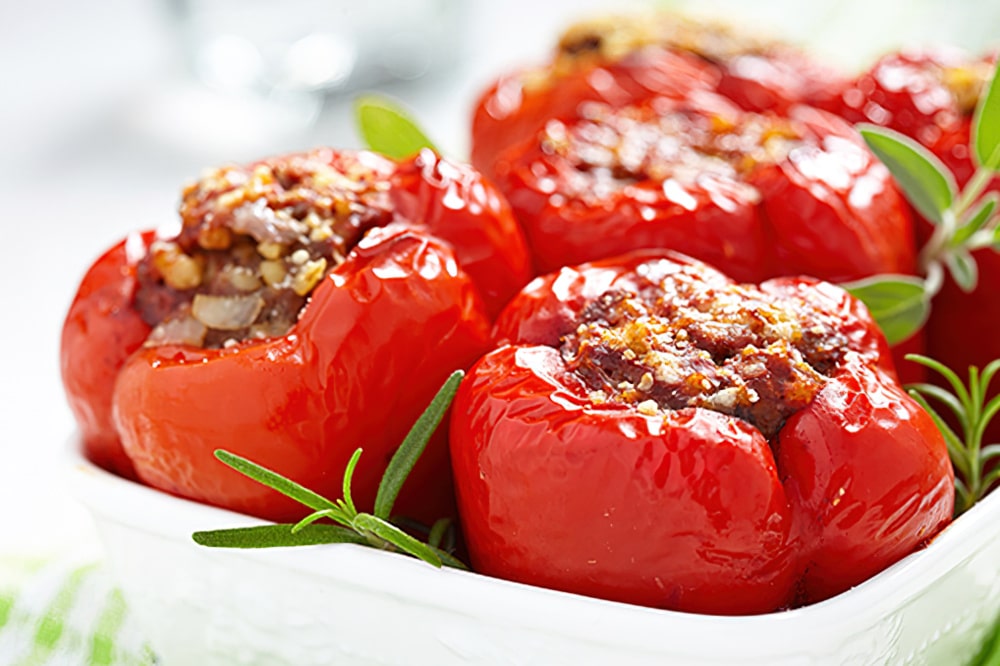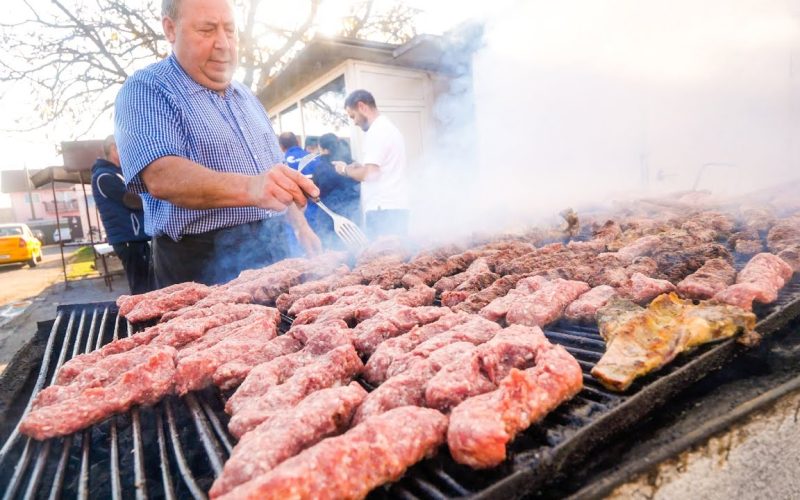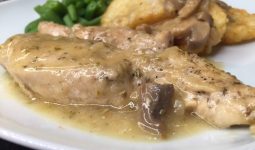Romanian cuisine synthesizes foreign culinary influences, primarily from the old Roman, Turkish, Hungarian, and Balkan cuisines and indigenous Dacian customs.
Have a taste for Romanian street foods? This lesser-known cuisine creates incredibly tasty dishes by combining various Ottoman and Balkan influences.
These are the most well-liked Romanian street foods you must try, regardless of whether you want to travel there or add some Romanian cuisine to your kitchen.
Let’s go!
1. Ardei Umpluţi

If you like Balkan cuisine, you will be familiar with the first on our list of Romanian street foods.
The term “stuffed pepper” (order umpluţi) in Romanian describes the regional variation of dolma, a well-liked meal made of rice and ground beef within hollowed-out peppers.
Many nations in the Balkans and beyond, including Bosnia and Herzegovina, Serbia, Croatia, Albania, Georgia, and Armenia, are fond of stuffed peppers.
Any vegetable can be used to make these. Still, in Romania, the term “ardei umpluţi” is reserved for bell peppers, primarily yellow but also red and kapia varieties, that have been filled with a mixture of ground pork, white rice, herbs, onion, garlic, and spices.
2. Frigărui
Frigarui is also one of the Romanian street foods. The classic recipe for Romanian kebab, known as frigărui în Romanian, calls for overnight marinating chicken breasts, which are subsequently grilled either alone or with veggies.
You can also make this meal with other meats such as beef, pork, gammon, or bacon.
Unlike chopped cubes, the preferred meat is arranged on skewers or combined with cubed veggies, like peppers, tomatoes, or mushrooms.
Street vendors frequently serve Romanian kebabs with mujdei de usturoi, a typical garlic sauce.
3. Salată de Boeuf
The term “salată de boeuf” (literally, “beef salad”) describes the Romanian version of “olivye salad,” or “Russian salad.”
This particular variety of potato salad was created and made famous in the 1860s by Russian chef Lucien Olivier, a Belgian-French chef who operated the Hermitage restaurant in Moscow.
Although salată de boeuf, as its name implies, was traditionally cooked with beef, it can now also be made with chicken, turkey, and occasionally pork.
They are combined with finely chopped potatoes, root vegetables, and murături (pickled vegetables from Romania), then covered in a thick layer of mayonnaise and topped with hard-boiled eggs and vegetable pieces.
It’s also possible to combine sweet mustard in some regions of Romania.
Like sarmales or stuffed cabbage rolls, these Romanian street foods are usually served during the holidays in Romania.
It’s frequently prepared in honor of Easter, the New Year, and Christmas.
4. Salată de Vinete
Salată de vinete, a well-known aubergine salad or dip from Romania, combines puréed and roasted aubergine with lemon juice, sunflower oil, and salt.
It is quite similar to baba ghanoush from Lebanon. However, it contains no tahini (toasted sesame seed paste).
Although these Romanian street foods are usually made with just four ingredients—eggplant, lemon juice, sunflower oil, and salt—they can also be made with extras like onions, garlic, and homemade mayonnaise.
Traditionally, slices of fresh tomato and crusty bread are served with it during the summer.
5. Pork Tacos
We went to Mexican food for our next meal. We went by Dumas Van and decided to get some tacos there. We had corn tortilla-wrapped meat tacos.
The tacos had a great spicy flavor. The meat was succulent and soft. We could not distinguish between the sauce within and the sauce on the tacos.
The sauce’s sweetness and spice levels were precisely right. It tasted really good.
6. Mici
A staple meal in Romania is called Mici, which are essentially little balls of ground meat.
The translation of the word Mici is “small.” These Romanian street foods were smoky and gleaming as they were cooked on the grill.
The Mici were served with mustard sauce, but you could also request Romanian cheese to go with them.
The slow-cooked meat was delicious, especially when paired with the mustard.
Additionally, the meat has various seasonings that give it a really flavorful taste. The tender meat, mustard, and cheese flavor combo was amazing.
7. Covrigi
There is a kind of Romanian pretzel known as covrig. Made with leavened dough twisted and baked, it’s topped with big salt granules and various seeds, often sunflower, sesame, poppy, or pumpkin seeds.
In Romania, one of the most well-liked street snacks is covrigi.
Covrigarie, also known as simigerie, are Romanian pretzel shops where you may have them plain or stuffed with various flavors, such as chocolate, cheese, fruit, or sausage.
Covrigi, sometimes known as Romanian pretzels, are made from yeasted dough twisted into a pretzel shape.
These Romanian street foods are often topped with poppy, sesame, or salt before baking, but more recent iterations have also included cheese, jams, fruit, chocolate, or walnuts as fillings.
The regional variation in Dobrogea frequently includes chopped olive and sultana pieces. Covrigi are mostly sold at street kiosks (covrigarie), where they are typically released as street food.
8. Gulaș
The term “gulaş” denotes the Romanian translation of goulash, which is a well-known Hungarian beef stew flavored with paprika and additional spices.
Before extending to other areas of Romania, it established itself in the Ardeal region.
Although there are gulaș recipes to match the number of Romanian cooks, the main ingredients are meat (often pork or beef), onions, and paprika.
Tomatoes, garlic, carrots, red peppers, parsley, bay leaves, and cumin are more typical components.
Romanian gulaș, a robust and satisfying dish that is frequently served with mămăligă and garlic, is usually cooked using dumplings. However, potatoes can also be used.
9. Fasole cu Ciolan Afumat
The traditional Romanian pork and beans stew is called facolé cu ciolan afumat.
Dried beans and smoked pork hocks are stewed with onions, carrots, tomato paste, cumin, paprika, bay leaves, and seasonings to create this filling and cozy dish.
Fasole cu ciolan is a traditional Romanian dish consisting of beans and smoked pork meat.
10. Ostropel de Pui
Ostropel de pui, which translates to “chicken stew,” is one of the classic Romanian street foods made with chicken cooked in a thick tomato sauce that has been seasoned with pepper, garlic, spring onions, and other spices.
Although chicken drumsticks or thighs are frequently used, other proteins like pork, rabbit, or lamb can also be used.
You can even completely omit the meat and replace it with potatoes or other substantial vegetables. Chicken is fried and then added to a boiling mixture of water, oil, tomato purée, flour, garlic, and onions to make ostropel de pui.
Before being topped with parsley and served with a side of mămăligă, or boiled/mashed potatoes, the stew is cooked until the sauce thickens.
11. Mititei
A comprehensive Romanian culinary guide would be incomplete without including mititei (also known as mici), grilled meat rolls, or skinless sausages prepared from a blend of beef, lamb, pork, garlic, and spices.
It is commonly regarded as the national dish of Romania and is the local variation of ćevapi.
The word “little ones” in Romanian is mititei. Made with ground meat (beef, lamb, or hog), these well-liked grilled minced meat rolls are seasoned with various herbs and spices, including paprika, savory, black pepper, anise, coriander, and thyme.
At Romanian barbecues, they are usually grilled outside and eaten with pickled vegetables, mustard, and french fries. As you might expect, they pair wonderfully with beer as well.
Although mititei are eaten all over Romania, it is thought that they originated in a Bucharest restaurant in the late 1800s.
Legend has it that one day, the cook ran out of sausage casings and had to get creative, cooking the skinless sausages straight on the grill.
Once the dish gained popularity, it became a mainstay at every barbeque and one of the most well-liked Romanian street foods.
They are served at street food stands, picnics, taverns, and restaurants in Romania.
Every year on May 1st, an estimated 30 million mititei are grilled and consumed as part of International Workers’ Day celebrations.
They have since become the dish of choice for this occasion. For the most part, traditional Romanian meals that are cooked on a grill are called mititei, or skinless sausages.
12. Slănină
The Romanian word for salo, a classic meal made of cured pork fatback slabs, is slănină.
It is frequently consumed as a snack in many European nations, including Romania, Russia, Ukraine, Hungary, Lithuania, and Czechia.
Salo comes from many places and can be prepared differently.
These Romanian street foods can be prepared with or without the skin and can be brine-cured or dry-salted.
Unlike bacon, it contains little to no lean meat and can be smoked or flavored with paprika, garlic, salt, black pepper, and other ingredients.
In Romania, slănină is created by curing hog fat in brine for 2-3 weeks and then smoking it for several days.
It can be eaten raw or cooked and used as an ingredient in Romanian food.
It can be grilled, fried, or served with bread, Romanian cheese, and red onions when eaten as a snack.
Slanina pork fatback is a traditional meal that can be consumed as is or utilized in numerous Romanian food recipes.
13. Rasol
Rasol is a typical Romanian street food made with meat, potatoes, and various vegetables like carrots, tomatoes, and onions.
Chicken and pork are the most typical proteins. However, they can be cooked with many fresh meat and poultry types, such as beef, duck, turkey, and goose.
Rasol is commonly served on a plate with some stock and a side of horseradish, mujdei (combination of chopped garlic, sunflower oil, water, and spices), sour cream, and mămăligă. Rasol is a typical Romanian dish of boiling meats and veggies.
14. Ciulama
Ciulama is a typical Romanian and Moldovan meal with beef and/or mushrooms served in a white roux sauce.
It’s frequently cooked with chicken (ciulama de pui), turkey (ciulama de curcan), or veal (ciulama de vițel) and served with a side of mămăligă or mujdei. Romanian delicacy ciulama, served with a white roux sauce.
15. Drob de Miel
Should you be lucky enough to spend Easter in Romania, you might have the opportunity to sample drob de miel, a customary meal prepared with lamb offal.
Known by another name, “lamb haggis,” it is the centerpiece of every Romanian Easter dinner.
The best thing about drob de miel is that it’s created from the less glitzy but frequently tastier portions of lamb.
To make the stuffing for the meal, lamb’s liver, spleen, heart, lungs, and kidneys are boiled, minced, and combined with raw eggs, parsley, dill, green onions, and bread soaked in milk.
It can also be made with chicken liver. Traditionally, it is made with lamb offal.
The mixture is combined with hard-boiled eggs, and then the bread is wrapped in the fatty membrane of the lamb and cooked.
Sliced and eaten like meatloaf, the meal is prepared when cooked.
Though more contemporary variations usually use puff pastry or spaghetti sheets instead of caul, drob de miel is originally made with the latter.
16. Sarmale
Sarmalee, which is Romanian for “ardei umpluţi,” is a stuffed vegetable dish that is famous throughout the Balkans and beyond, including Serbia, Bosnia and Herzegovina, Croatia, Greece, Turkey, Ukraine, and Lithuania.
It alludes to a variation of dolma made of rice and minced pig stuffing inside cabbage or vine leaves.
Like dolma, these Romanian street foods can be prepared differently in many nations.
Pickled cabbage leaves are usually wrapped around a filling resembling dolma, which is made up of minced pig, rice, onions, and seasonings in Romania.
After that, the stuffed cabbage rolls are cooked in tomato juice, smoked bacon, and thyme.
They are then served with loads of sour cream, mămăligă (Romanian polenta), and bread.
In Romania, sarma can also be cooked with vegetables and mushrooms, depending on the season.
These are cooked without any meat filling and are called sarmale de post.
Sarmale is so widely consumed in Romania that many consider it a national cuisine. It’s delicious and quite comforting.
Although it’s enjoyable all year round, it gains particular traction during the Christmas and Easter seasons.
17. Varză a la Cluj
Varză a la Cluj is definitely something you should try if you appreciate Romanian cabbage rolls.
It’s a Transylvanian casserole consisting of rice, tomato sauce, sour cream, onions, and cooked sour cabbage covered with spiced minced pork.
A specialty of Cluj-Napoca in northwest Romania is Varză a la Cluj.
It is offered at many eateries in the city, frequently accompanied by mămăligă, hot peppers, and sour cream. Varza a la Cluj is Romania’s sour cabbage and minced pork dish.
18. Cârnați
Cârnați is next on our list of Romanian street foods. They are spicy pig sausages from Romania made with garlic.
They are created with various herbs and spices, including chili flakes, garlic, paprika, thyme, black pepper, and salt, and can be smoked or dry-cured.
19. Jumări”
The term “jumări” describes the dry pork left over after the fat has been rendered and seasoned with salt, garlic, and onions.
You might think of it as a kind of pork crackling or Romanian rind, typically eaten as a snack in the winter.
Jumări is frequently used to enhance the flavor of various Romanian street foods, such as varză con jumări and fasole cu jumări.
20. Tochitură
A delectable Romanian delicacy called tochitură is created with pigs, sausages, and bacon that has been smoked.
There are several methods to make it, depending on where you are from, but it is similar to a stew but with very little sauce.
Although it can also be made with different meats such as cattle, lamb, chicken, and offal, pork is the most popular.
While there are many different recipes, there are essentially two kinds of tochitură în România: those made with and those made without tomato sauce.
While the former is more popular and what you’d often get in a Romanian restaurant, the latter is more traditional.
When using tomato sauce, the meats are cooked in their juices and fats for a minimum of time, and then a small bit of sauce is added towards the end, along with minced garlic.
Tochitură, like many other recipes in this Romanian culinary guide, is frequently served with mămăligă.
These Romanian street foods are also frequently served with a fried egg and salty sheep cheese, such as brânză de burduf or telemea.
21. Pomana Porcului
Pomana porcului, which translates to “pig’s alms,” is ending our list of Romanian street foods.
It is a traditional Romanian dinner that was served to the men who participated in the killing of the pig.
This is a straightforward dish created with sausages, offal, and different types of pig that are cooked in lard and served with onions, mijdei, or mămăligă.
One of the most significant traditional Romanian dishes connected to Ignat Day is pomana porcului.
Conclusion
Because of popular culture, Dracula is the most prominent figure in many people’s perceptions of Romania.
However, as this article is about Romanian street foods, there are many other interesting things to see and do in this little-known nation in southeast Europe.
If you’re not into blood (or lurid legends), our post to Romanian street foods will provide you with something more appetizing to try when you visit again.








